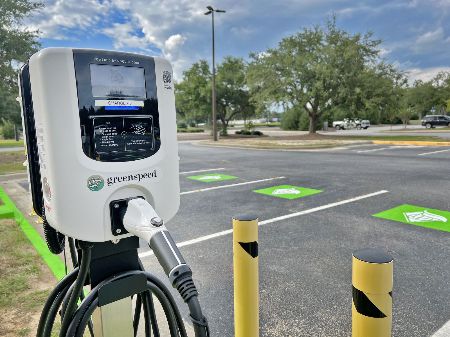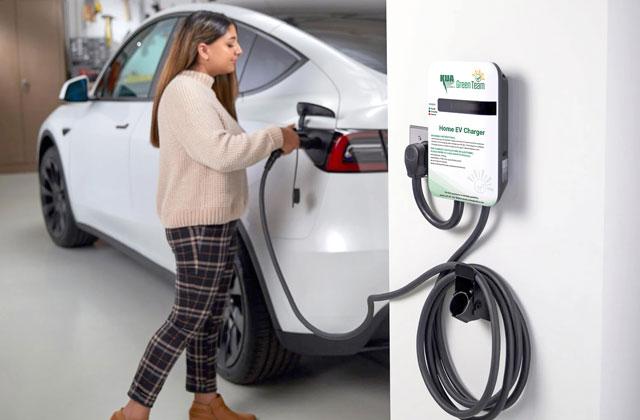Top Reasons Why It’s Essential to Buy EV Charging news Regularly
Top Reasons Why It’s Essential to Buy EV Charging news Regularly
Blog Article
Top EV Charging Information: Trick Updates on Infrastructure and Advancement

Recent Innovations in Fast-Charging Modern Technology

Additionally, developments in battery innovation, including enhanced thermal monitoring systems and higher power density batteries, enhance fast-charging capabilities. These developments minimize the danger of battery destruction during quick charging, guaranteeing long life and performance for EV owners.
Furthermore, the assimilation of smart billing services is boosting user experience, allowing real-time surveillance and dynamic pricing designs. EV Charging news. This flexibility enables vehicle drivers to optimize charging times and expenses based upon grid demand
As car manufacturers remain to invest in fast-charging networks, the partnership between market stakeholders is critical. Partnerships between charging terminal carriers and automotive producers are leading the method for considerable coverage, inevitably cultivating a more durable EV ecosystem. These developments are critical in supporting the change to sustainable transportation.
Government Efforts for Billing Growth
Government initiatives play an important duty in the development of electrical automobile (EV) charging facilities, helping with the transition to sustainable transport. Numerous government and state programs are being carried out to improve charging ease of access, reduce the monetary concern on consumers, and advertise the fostering of electrical cars.
Especially, the united state federal government has assigned significant financing with the Infrastructure Financial Investment and Jobs Act, which sets aside $7.5 billion for EV billing network advancement across the country. This funding is targeted at deploying countless new charging terminals, especially in underserved areas, therefore attending to range anxiety amongst prospective EV buyers.
In addition, many states are enacting regulation to improve the allowing procedure for charging terminal installations, which is crucial for speeding up deployment. Motivations such as tax credit scores and discounts for both consumers and organizations are likewise being presented to motivate the installment of charging framework.
Additionally, public-private collaborations are increasingly ending up being a focus, leveraging personal financial investment to complement federal government funding. These efforts emphasize a collective strategy important for developing a comprehensive and effective EV charging network, eventually adding to a greener and more lasting future.
Cutting-edge Battery Solutions Enhancing Efficiency
Revolutionizing the landscape of electrical vehicle (EV) innovation, cutting-edge battery services are considerably improving performance and efficiency. Advances in battery chemistry, especially with lithium-sulfur and solid-state batteries, are bring about increased energy density, which enables for longer arrays and faster billing times. These brand-new battery kinds have the potential to exceed standard lithium-ion batteries by providing higher capabilities while lowering weight, therefore boosting total vehicle efficiency.
Additionally, advancements in battery administration systems (BMS) are enhancing power usage and prolonging battery life expectancy. Smart algorithms monitor battery health and performance, making it possible for real-time changes to billing and releasing procedures. This not just boosts the performance of the battery however likewise makes sure a much more lasting and trustworthy energy source for EVs.
Furthermore, the integration of reusing innovations is dealing with the environmental impact of battery manufacturing and disposal. Innovations in second-life applications for EV batteries are facilitating their use in power storage systems, contributing to a circular economy.
As these cutting-edge battery options continue to evolve, they assure to transform the EV market, making electric cars more this article accessible and enticing to a more comprehensive audience while sustaining worldwide sustainability goals.

Collaboration Between Automakers and Charging Networks
Recognizing the crucial requirement for a durable billing visite site framework, car manufacturers are significantly teaming up with billing network providers to improve the EV possession experience (EV Charging news). These partnerships aim to produce a seamless charging community that benefits consumers and supports the shift to electric cars
Major automotive brands are signing up with pressures with well-known charging networks to expand their charging terminal protection, making certain motorists have accessibility to trustworthy and practical charging options. For instance, collaborations with networks like ChargePoint and Electrify America permit car manufacturers to incorporate charging solutions straight into their cars' navigation systems, assisting customers to the closest terminals and offering real-time availability updates.
Furthermore, these cooperations commonly result in the growth of fast-charging innovations that significantly minimize the time required to recharge an EV. By merging resources and expertise, car manufacturers and billing networks can innovate much faster, producing remedies that satisfy the expanding demand for electrical mobility.
On top of that, joint initiatives may additionally result in even more standardized charging methods, which can reduce customer confusion and promote more comprehensive EV fostering. In general, these critical alliances are critical in constructing a straightforward and reliable charging framework that fulfills the demands of an expanding electrical lorry market.
Challenges Encountering EV Charging Facilities
As the electrical vehicle market continues to grow, a number of obstacles are appearing that impede the growth of an extensive billing framework. Among the primary obstacles is the insufficient number of charging stations, especially in country and underserved urban areas. This space develops pop over to this site array anxiety among prospective EV purchasers, preventing them from making the button.
In addition, the absence of standardization in billing modern technology makes complex the facilities landscape. Variants in plug kinds and billing rates can create confusion for individuals and increase operational complexities for charging network operators. The assimilation of billing terminals into existing electrical grids poses substantial challenges. Many areas encounter capability restrictions, requiring substantial financial investments in grid upgrades to suit enhanced demand.
Another pushing concern is the high expense associated with the installment and maintenance of charging terminals, which can be a barrier for both public entities and private organizations. Regulatory difficulties and zoning limitations can postpone the deployment of billing facilities, impeding development in expanding necessary services. Resolving these challenges will certainly be critical for promoting a robust EV environment that supports the shift to lasting transportation.
Verdict
In conclusion, the continuous innovations in EV billing technology, supported by considerable federal government campaigns and ingenious battery options, are crucial for the development and performance of electrical car infrastructure. Cooperations in between automakers and billing companies further improve terminal insurance coverage, addressing the growing need for accessible charging options. Despite challenges that continue within the EV billing landscape, these growths signify a favorable trajectory towards a much more sustainable and effective electric automobile environment.
Advancements in billing facilities have led to the development of ultra-fast chargers qualified of supplying up to 350 kW of power, substantially minimizing charging times. Variations in plug kinds and billing speeds can create confusion for users and increase functional complexities for charging network drivers.In final thought, the ongoing advancements in EV billing innovation, supported by considerable federal government initiatives and cutting-edge battery options, are vital for the growth and efficiency of electrical automobile infrastructure. Cooperations in between automakers and billing companies even more boost station coverage, resolving the expanding demand for easily accessible charging alternatives. Despite obstacles that continue within the EV billing landscape, these advancements symbolize a positive trajectory in the direction of a more sustainable and effective electrical car ecological community.
Report this page